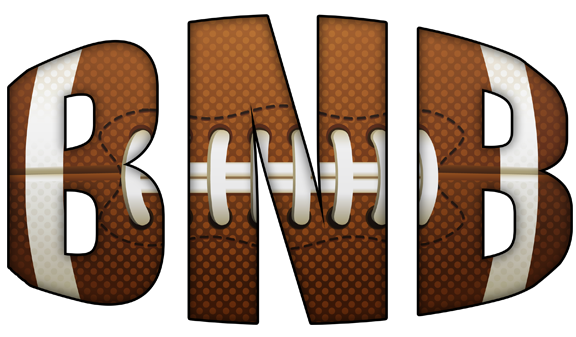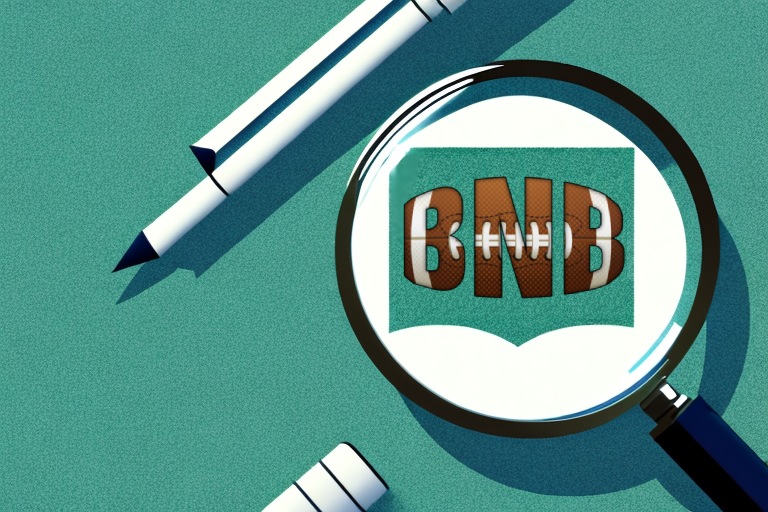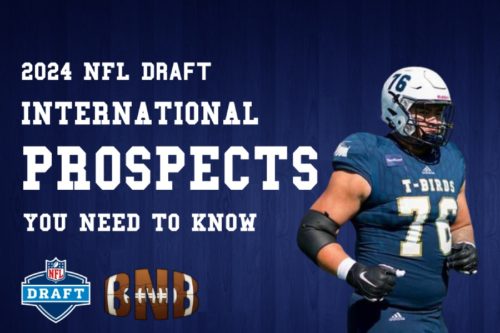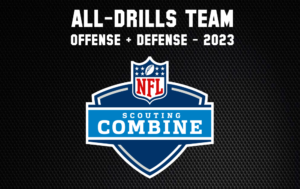Learn how to effectively scout NFL draft prospects with this comprehensive guide.
NFL Draft scouting has always been a critical piece of building a winning team. Teams invest a significant amount of time, resources, and manpower to identify and evaluate potential prospects who can make a difference on the field. This comprehensive guide aims to provide a detailed insight into the art of scouting NFL draft prospects, covering everything from understanding the basics to assessing off-field factors.
Quick Links:
The Basics of NFL Draft Scouting | Starting the Scouting Process | Prospect Analysis | College Performance | Off-Field Factors
Understanding the Basics of NFL Draft Scouting
Before diving into the intricacies of scouting, it is important to grasp the concepts that underpin the process. At its core, scouting involves the evaluation of players to determine their overall potential and fit within a team’s system. College scouts play a vital role in providing teams with valuable insights into a player’s strengths, weaknesses, and overall suitability for the NFL. By examining various key areas, scouts aim to assess a player’s talent, character, and potential impact on the field.
When it comes to evaluating talent, scouts take into consideration a range of factors. Some of these factors are coachable skills, but many are uncoachable. A prospect either has it or they don’t. These include a player’s physical attributes, such as size, speed, strength, and agility, to determine their athletic potential. Scouts closely examine a player’s technical skills, including their ability to throw, catch, tackle, and block effectively. They also evaluate a player’s football IQ, assessing their understanding of the game, decision-making abilities, and situational awareness.
Character evaluation is another crucial aspect of the scouting process. Scouts delve into a player’s background, looking for any red flags or off-field issues that could potentially impact their performance or behavior as a professional athlete. They conduct interviews with the player, their coaches, and teammates to gain insights into their work ethic, leadership qualities, and ability to handle pressure.
The Role of a Scout in the NFL Draft Process
A draft scout serves as the eyes and ears of an NFL team, responsible for gathering information and evaluating college prospects. They are tasked with evaluating players from college programs, providing comprehensive reports to team decision-makers. The information gathered helps teams make informed decisions and build championship-caliber rosters.
Scouts spend countless hours watching game footage, attending practices and games, and conducting interviews to gather as much information as possible about a player. They meticulously analyze every aspect of a player’s performance, from their technique and skills to their competitiveness and consistency. Through their evaluations, scouts aim to identify players who have the potential to make an impact at the professional level and contribute to the success of their team.
Once the scouting process is complete, scouts compile their findings into detailed reports. These reports include an assessment of the player’s strengths and weaknesses, an analysis of their potential fit within a team’s system, and a projection of their future performance. These reports are then presented to team decision-makers, including coaches, general managers, and owners, who rely on the scouts’ expertise to make informed draft selections.
Key Skills Required for Scouting
Scouting is not as easy as just watching a football game. It requires a unique blend of skills, including keen observation, attention to detail, and an understanding of the game. Scouts must possess an ability to identify talent, assess player potential, and project how they may translate into the NFL. Additionally, strong communication and networking skills are crucial for building relationships with players, coaches, and other scouts.
Observation skills are essential for scouts to accurately assess a player’s performance. They must be able to identify subtle nuances in technique, positioning, and decision-making that can make a significant difference on the field. Attention to detail is also paramount, as scouts need to meticulously analyze every aspect of a player’s game to provide an accurate evaluation.
Understanding the game of football is crucial for scouts to effectively evaluate players. They need to have a deep knowledge of offensive and defensive schemes, as well as an understanding of the different positions and their respective responsibilities. This knowledge allows scouts to assess how a player’s skills and attributes align with the demands of specific positions and systems.
The Importance of Scouting for the NFL Draft
Scouting serves as the foundation of the NFL draft process. A well-executed scouting process can lead to the discovery of hidden gems and the development of championship teams.
Scouting provides teams with a competitive advantage by allowing them to make informed decisions based on comprehensive evaluations. It helps teams identify players who may have been overlooked by other teams, giving them the opportunity to acquire talent that can make a significant impact on the field. Additionally, scouting helps teams assess the risk associated with selecting certain players, taking into account their character, injury history, and potential for development.
Scouts need to know thousands of players. While fans often only know the first or second round picks, the real key to NFL success is converting on your late round picks.
While professional draft scouts are employed by NFL organizations, media scouts play a critical role in informing fans.
A media scout’s role can be even more challenging, as they’ll need to evaluate players without projecting how they’ll fit into one specific NFL system. Some prospects can be a great fit for one team, but a terrible fit for another team. Media scouts will need to leverage these two situations and provide a general ranking that suits both outcomes.
Starting the Scouting Process
Once the importance of scouting is understood, it is time to dive into the practical aspects of the process. The first step in scouting is identifying potential prospects who warrant further evaluation.
Identifying Potential Prospects
Scouts cast a wide net, scouring college programs and even international competitions to identify potential prospects. They analyze game footage, attend school practices and games, and gather as much information as possible to narrow down a list of players for further evaluation.
For amateur scouts who are trying to get involved in the process without being employed by a team or media outlet, here are a few places to begin when you’re identifying potential prospects:
- Senior Bowl Watchlist, East-West Shrine Bowl 1000: These preseason watchlists are released by the two biggest all-star games for draft prospects, and will include almost all of the top Seniors entering the season.
- All-Conference Teams: Many of the top draft prospects are already dominating the college game. Look through the past all-conference awards for some of your favorite conferences for a good list of names.
- Bruce Feldman’s Freaks List: A big part of draft scouting is the uncoachable physical traits. Bruce Feldman of The Athletic puts together an annual list of 100 college players with elite physical traits, and it’s a great way to find potential draft prospects.
- Pick a Region: Many pro scouts work in regions. If your favorite college team is in the Big10, start by diving deep into Big10 prospects. It isn’t realistic for a single scout to know everything about every prospect in the nation. Prove yourself by making accurate evaluations of a subset of prospects.
- NFL Draft Combine: The NFL Draft Combine is where all the top draft prospects come out. Roughly 250 players are drafted, and the top 350 players get a combine invite. Almost everyone who is drafted will be in attendance, and it’s a great list of names to get started.
Initial Evaluation of Prospects
Once prospects have been identified, the initial evaluation begins. Scouts assess physical attributes, such as size, speed, and agility, to determine if a player possesses the raw tools required to excel in the NFL. They also analyze a player’s football skills and techniques, evaluating their ability to execute the fundamental aspects of the game. Mental toughness and leadership qualities are also scrutinized, as these intangibles can significantly impact a player’s ability to succeed at the professional level.
It’s been said that you can tell if someone has “it” after only 5 plays. Future NFL players often jump off the screen with their speed, strength, and overall burst. Watching a full game footage or highlight film isn’t proper scouting, but it is the easiest way to access film and see a player’s athletic traits on the field.
Each individual position has a different set of skills required to succeed, so scouts need to understand exactly what to watch for.
Remember that “what happened” isn’t usually as important as “how it happened” in draft scouting.
For a cornerback, an interception is great. But you can have a winning rep even if the ball isn’t thrown in your direction. You can even have a solid rep when the ball ends up getting caught.
Likewise, you can have an impressive interception where you read a play and jumped the route, or you could just get an interception off a lucky bounce. How things happen is much more important than what actually happens, because draft scouting is all about future potential.
Delving Deeper into Prospect Analysis
With a pool of prospects identified and preliminarily evaluated, scouts must now delve deeper into their analysis to gain a more comprehensive understanding of each player’s capabilities.
Assessing Physical Attributes
Physical attributes play a crucial role in the success of an NFL prospect. Scouts meticulously evaluate a player’s strength, speed, agility, and overall athleticism. These traits are key indicators of a player’s potential and how they may match up against the competition at the professional level. A player’s physical attributes can make all the difference in their ability to succeed in the NFL.
Evaluating Football Skills and Techniques
Football skills and techniques are the building blocks of a successful NFL career. Scouts analyze a player’s ability to execute fundamental football skills, such as blocking, tackling, and catching. They assess a player’s technique, understanding of the game, and overall football IQ. A prospect’s ability to consistently perform these skills at a high level is a strong indicator of their potential for success in the NFL.
Analyzing Mental Toughness and Leadership Qualities
While physical attributes and football skills are crucial, mental toughness and leadership qualities cannot be overlooked. Scouts evaluate a player’s ability to handle pressure, make quick decisions, and persevere through adversity. Leadership qualities, such as communication skills and the ability to inspire teammates, are also crucial in the evaluation process. These intangibles can often be the differentiating factor between two closely matched prospects.
The Role of College Performance in Scouting
College performance provides valuable data points for scouts to assess a player’s potential at the NFL level. The following sections outline the key aspects that scouts consider when evaluating a player’s college performance.
Interpreting College Statistics
College statistics can provide critical insights into a player’s production and impact on the field. Scouts analyze various statistical categories, but it goes far beyond yards gained, touchdowns scored, and completion percentages.
New advanced metrics give necessary context to these traditional statistics, and can play a much bigger role in predicting NFL success.
It is also important to place statistics within the context of the player’s role, the level of competition faced, and the offensive and defensive schemes employed by their college team.
The Significance of Bowl Games and Championships
Bowl games and championship appearances offer prospects the opportunity to showcase their skills on a big stage. Scouts pay close attention to how players perform in these high-pressure situations, as it provides valuable insight into their ability to rise to the occasion. Strong performances in bowl games and championships can significantly enhance a prospect’s draft stock and increase their chances of success in the NFL.
Performance Versus Top Prospects
Another way to measure meaningful performance is watching them against future NFL players. A defensive end putting up 10 sacks in a season is nice, but if he put up 2 sacks against one of the top left tackles in the draft, that’s even more meaningful. If they struggled in their lone games against future NFL players, they might not have what it takes to translate their stats to the next level.
The Importance of Off-Field Factors
While on-field talent is paramount, off-field factors can also greatly influence a player’s success in the NFL. Scouts meticulously evaluate various off-field factors to determine if a prospect has the character and work ethic necessary to thrive in a professional environment.
Assessing Character and Work Ethic
Character and work ethic are valuable intangibles that can greatly impact a player’s career trajectory. Scouts conduct thorough background checks, interviewing coaches, teammates, and mentors to gain insights into a prospect’s character. They look for players who are dedicated, disciplined, and possess a strong work ethic. These qualities are often indicators of a player’s ability to handle the demands of an NFL career.
Evaluating Injury History and Longevity
Injury history and longevity are crucial factors in evaluating a prospect’s potential at the professional level. Scouts assess a player’s injury history, including the severity and frequency of injuries sustained throughout their college career. Additionally, they consider a player’s physical durability and how they may fare in the demanding NFL environment. Prospect durability and the ability to stay on the field can significantly impact their long-term success in the league.
Closing Thoughts: How to Scout NFL Draft Prospects
Scouting NFL draft prospects is an intricate process that requires a comprehensive evaluation of various factors. From understanding the basics to analyzing on-field and off-field attributes, scouts play a pivotal role in shaping the future of NFL franchises. By honing their skills, developing a keen eye, and leveraging their networks, scouts have the power to unearth hidden talents and build teams capable of achieving greatness.




